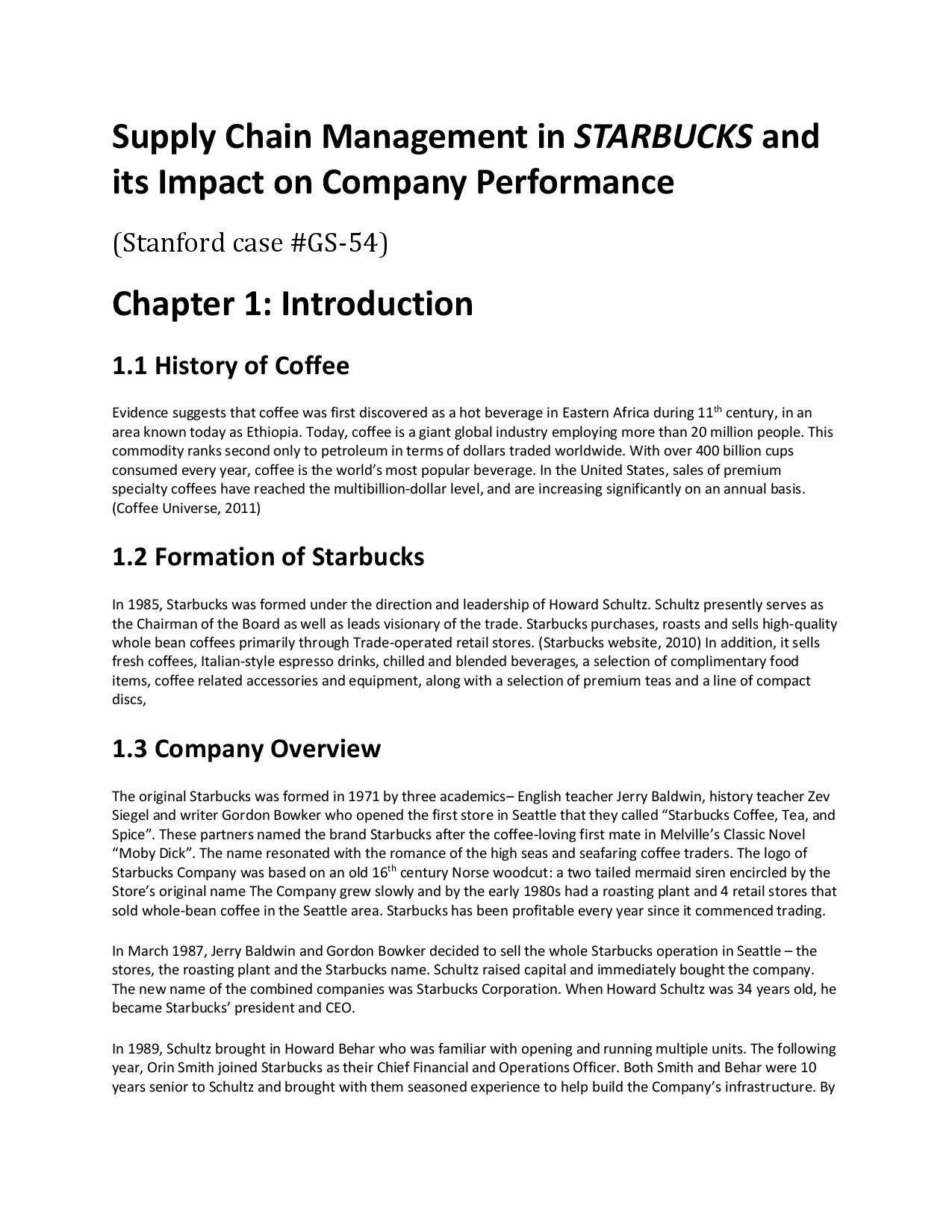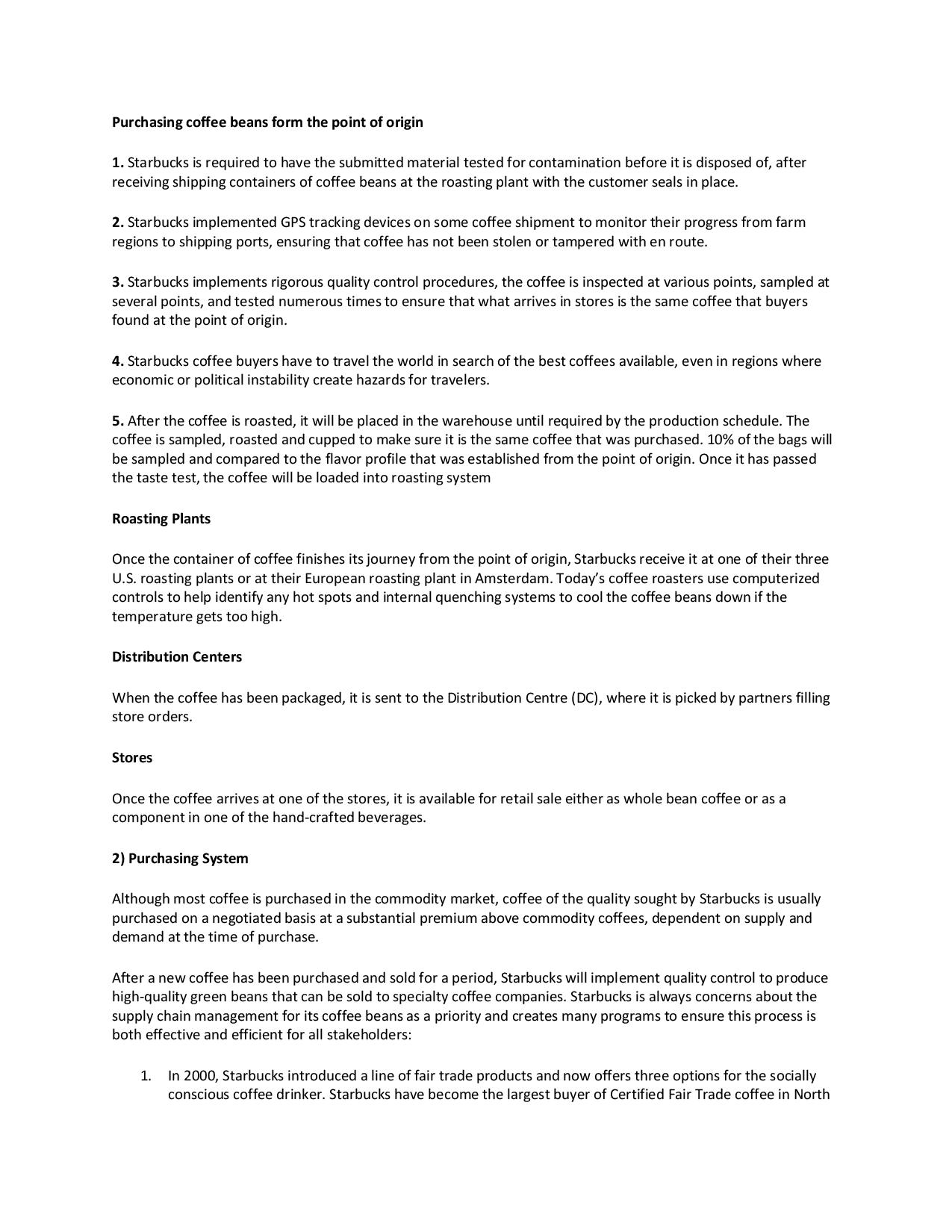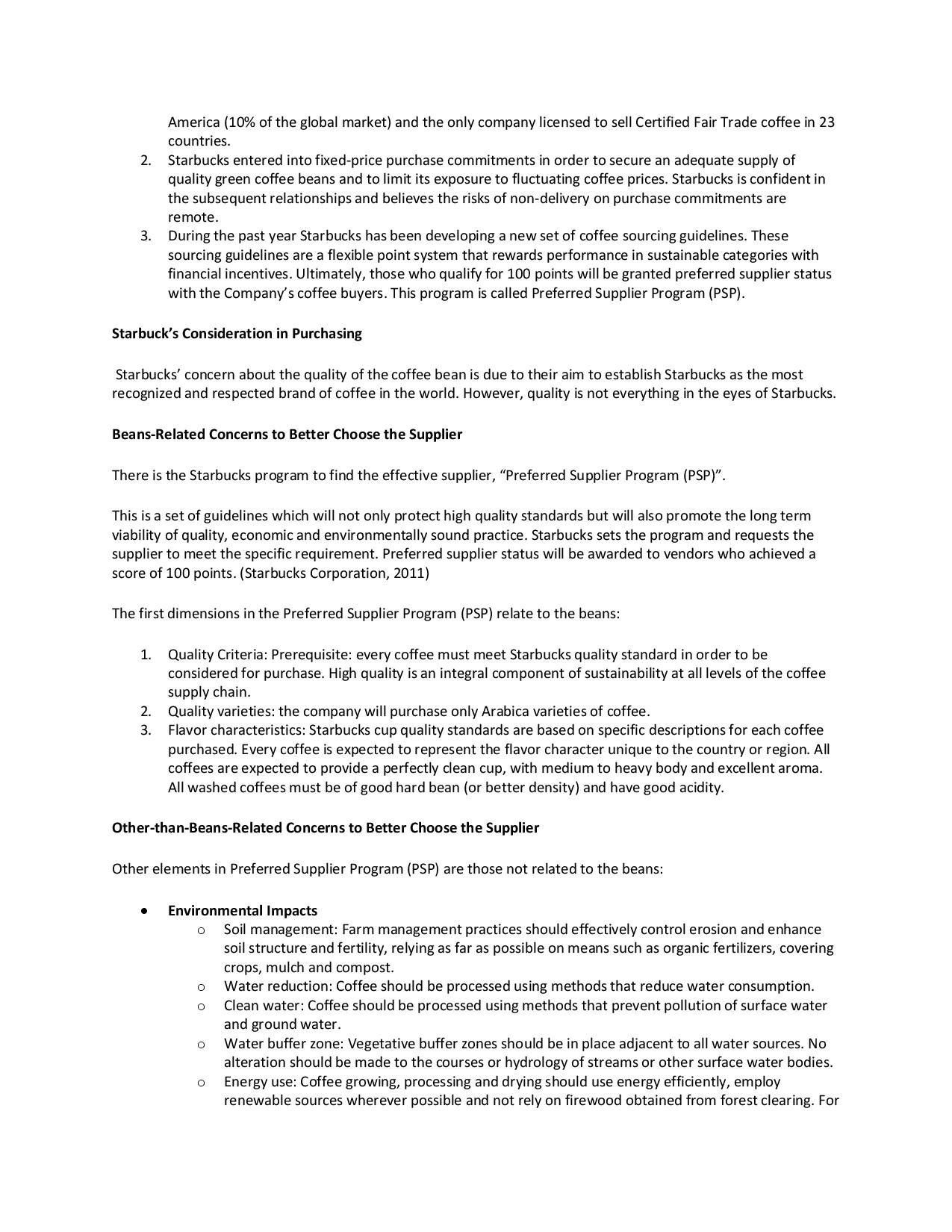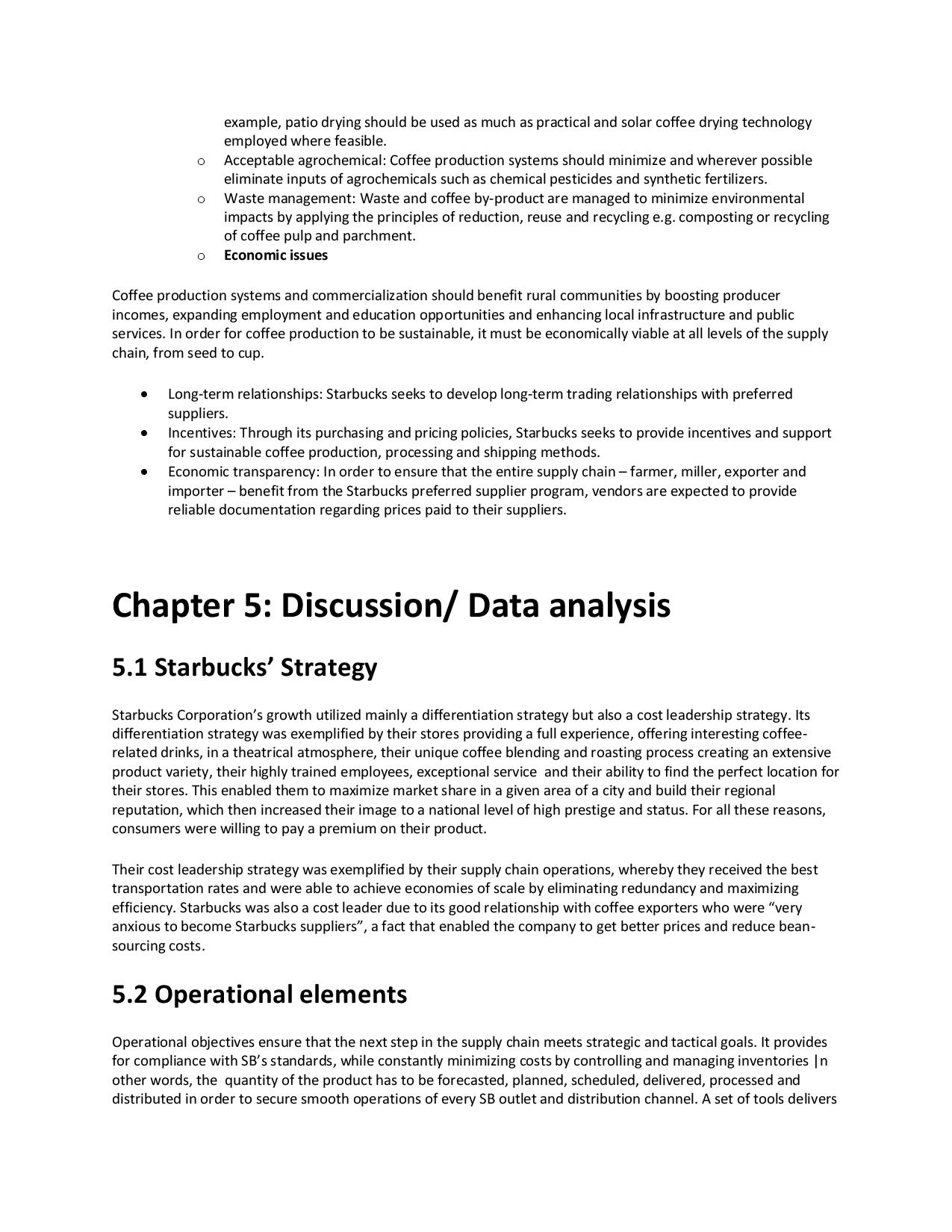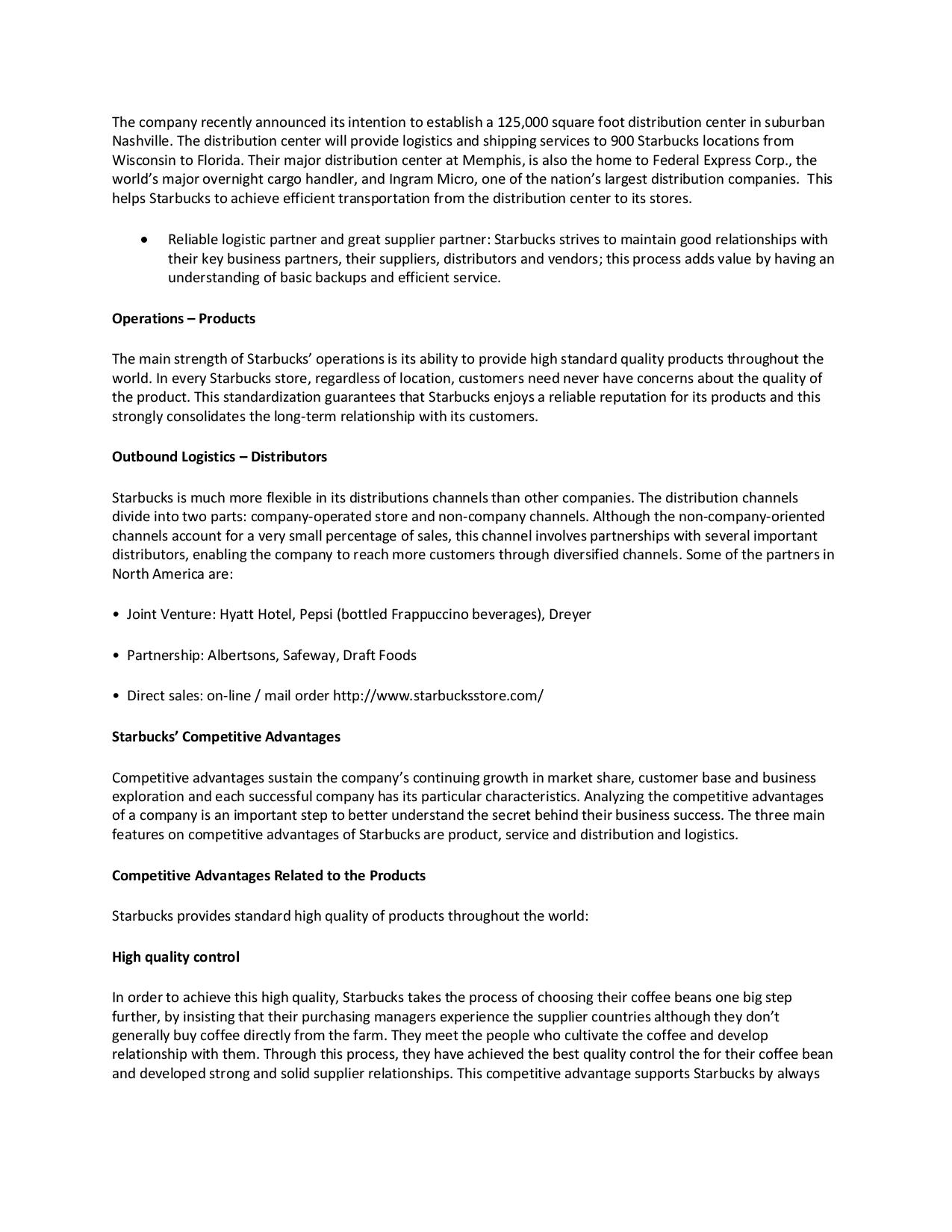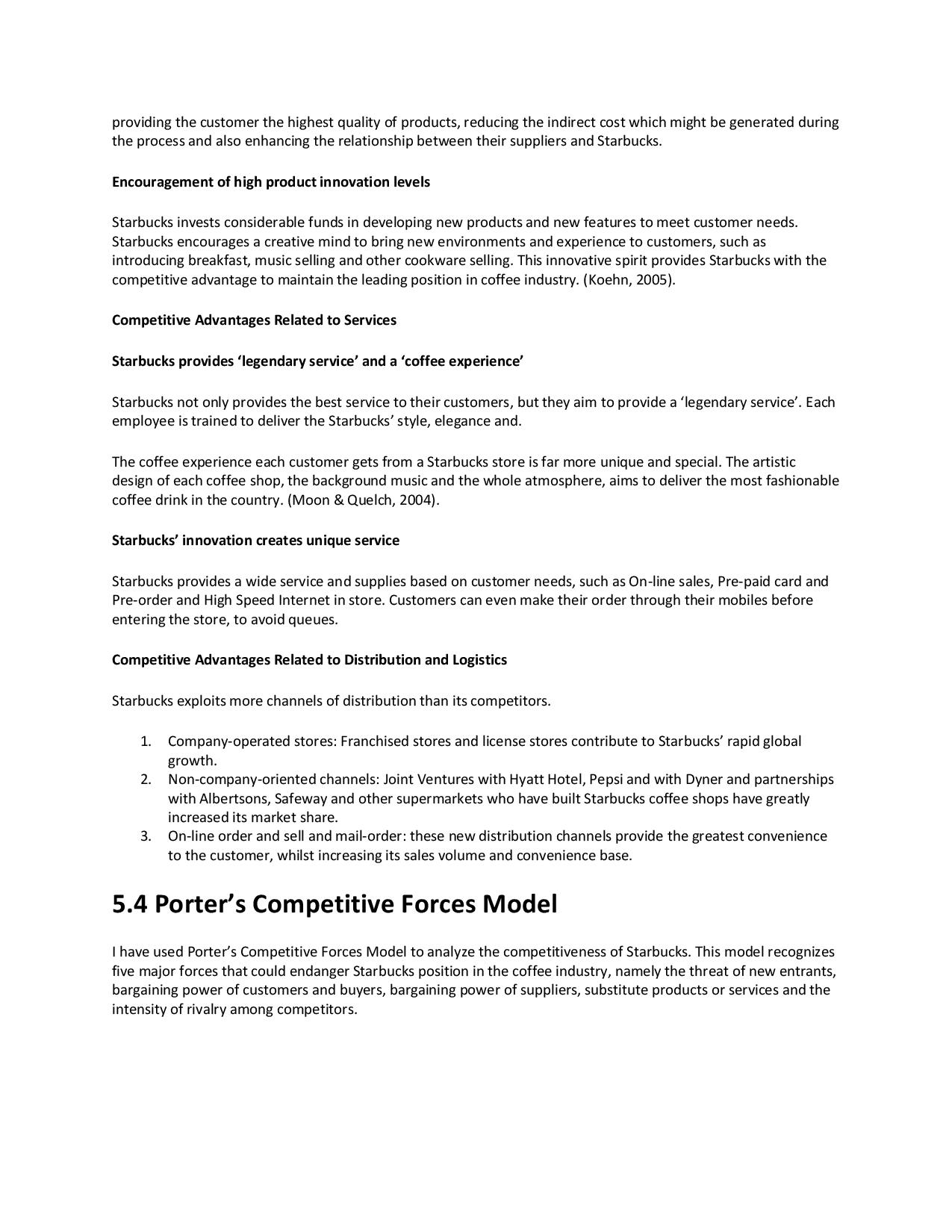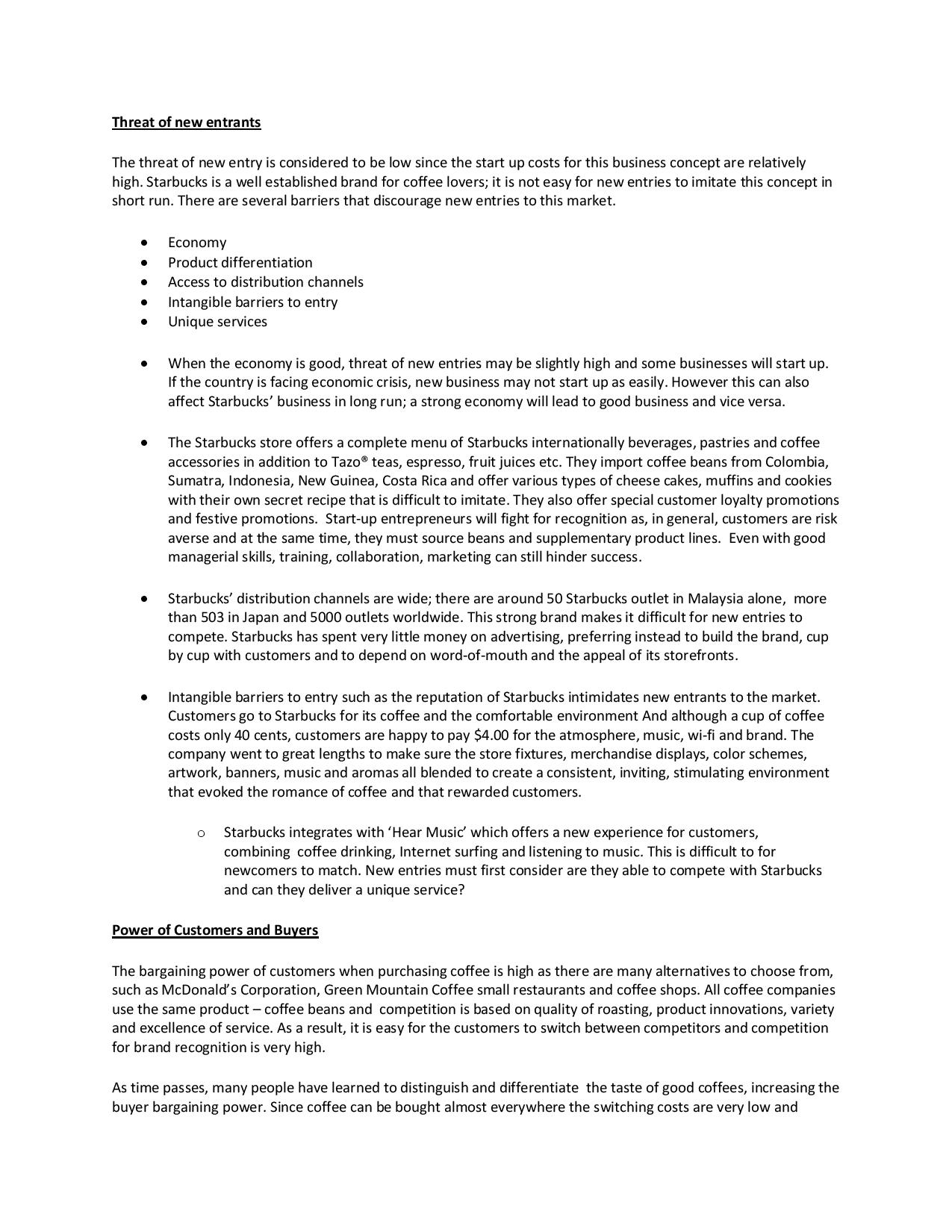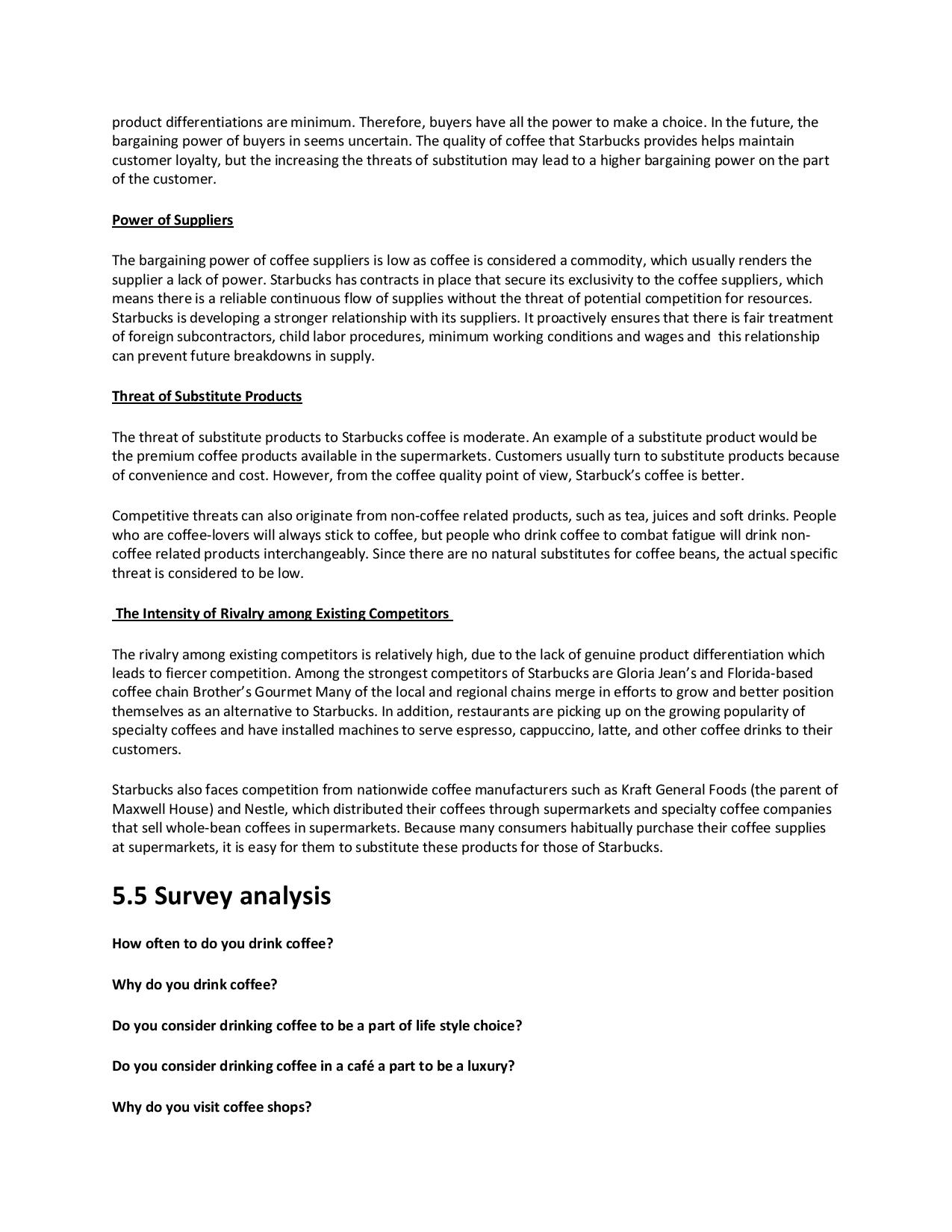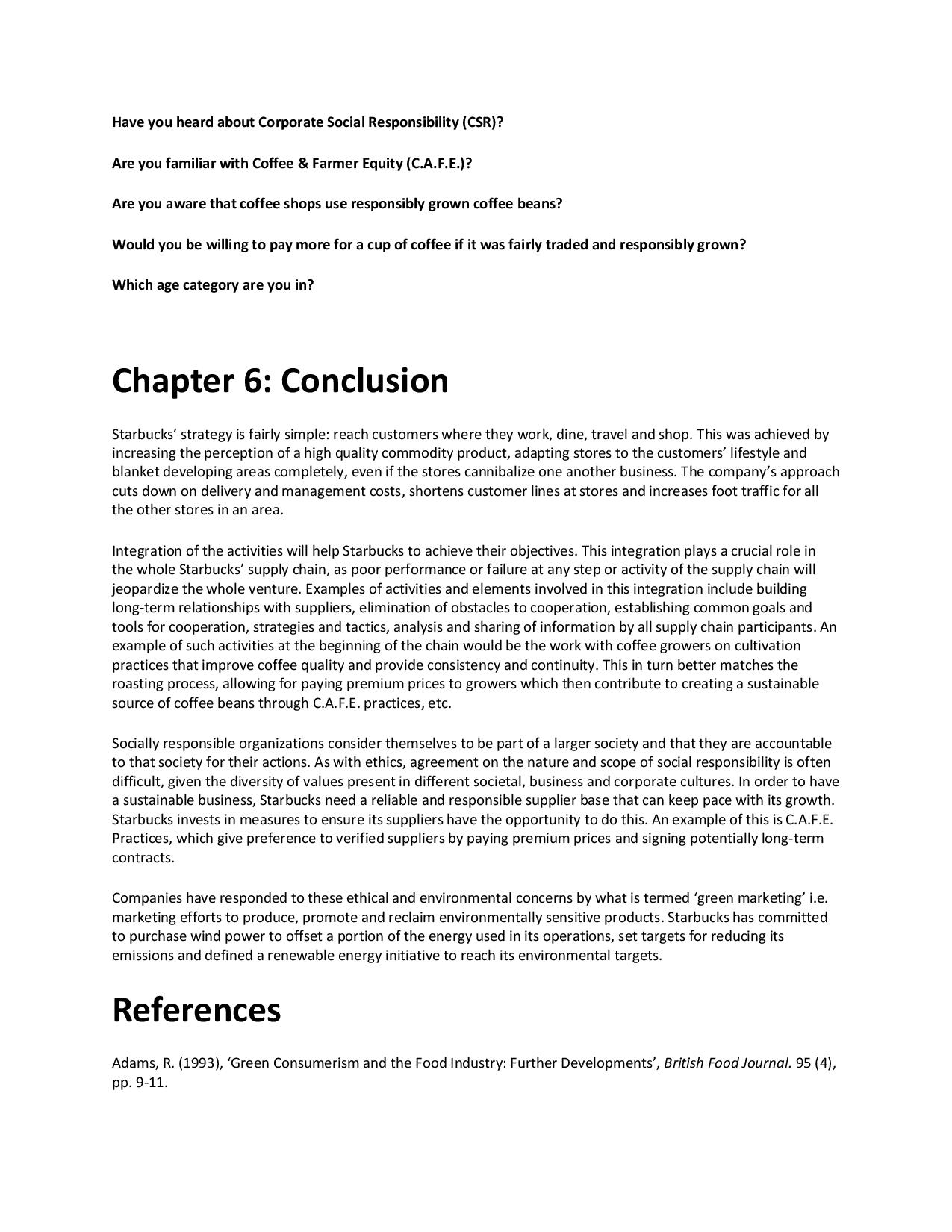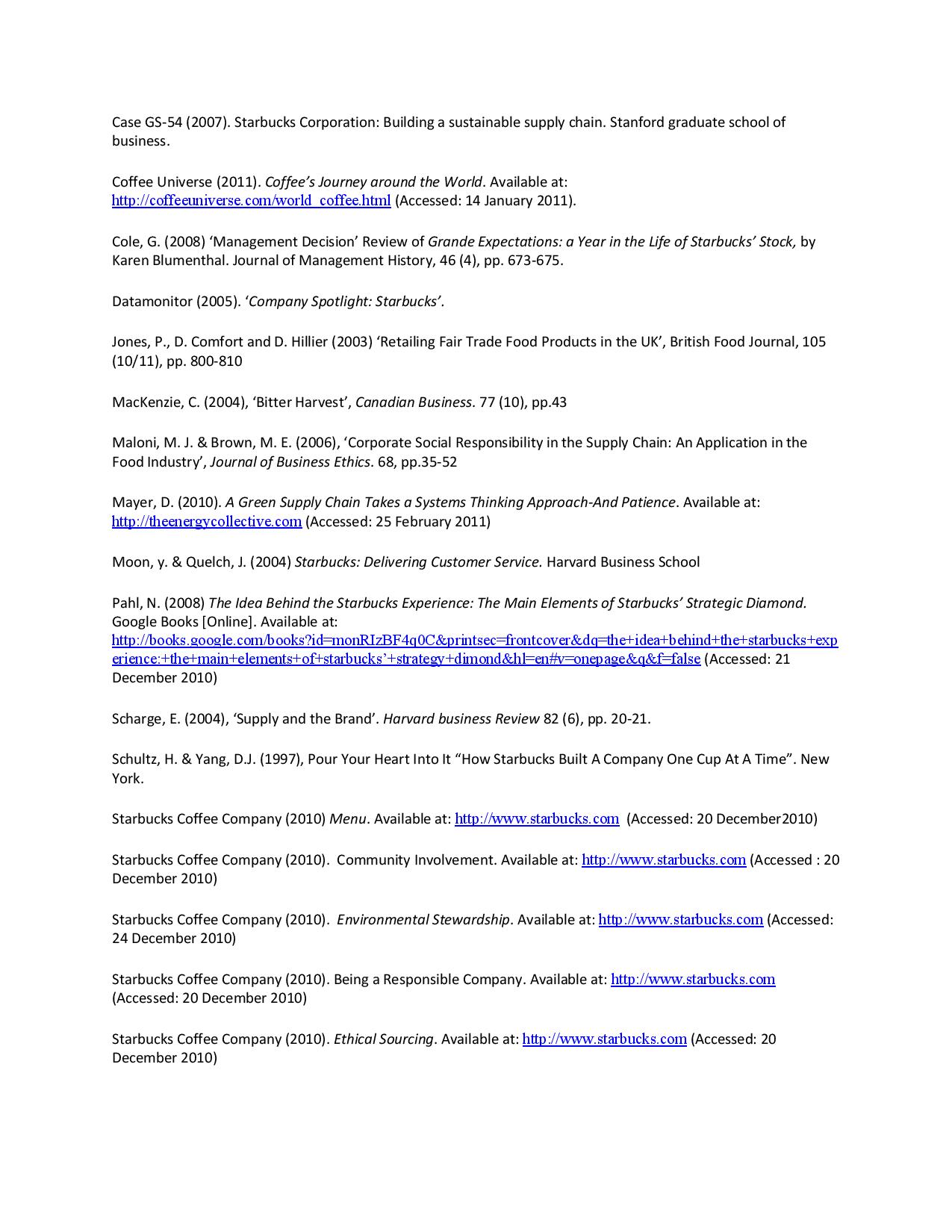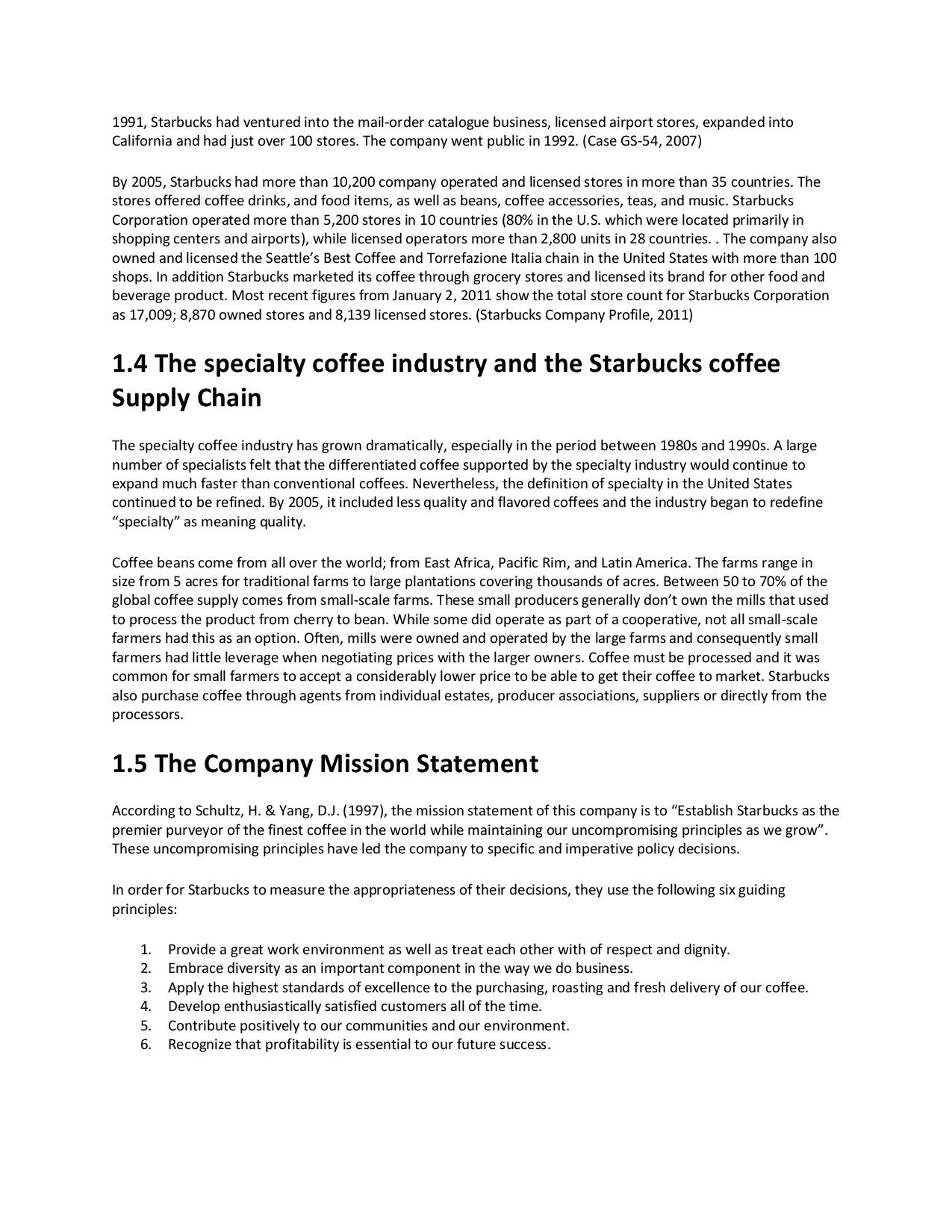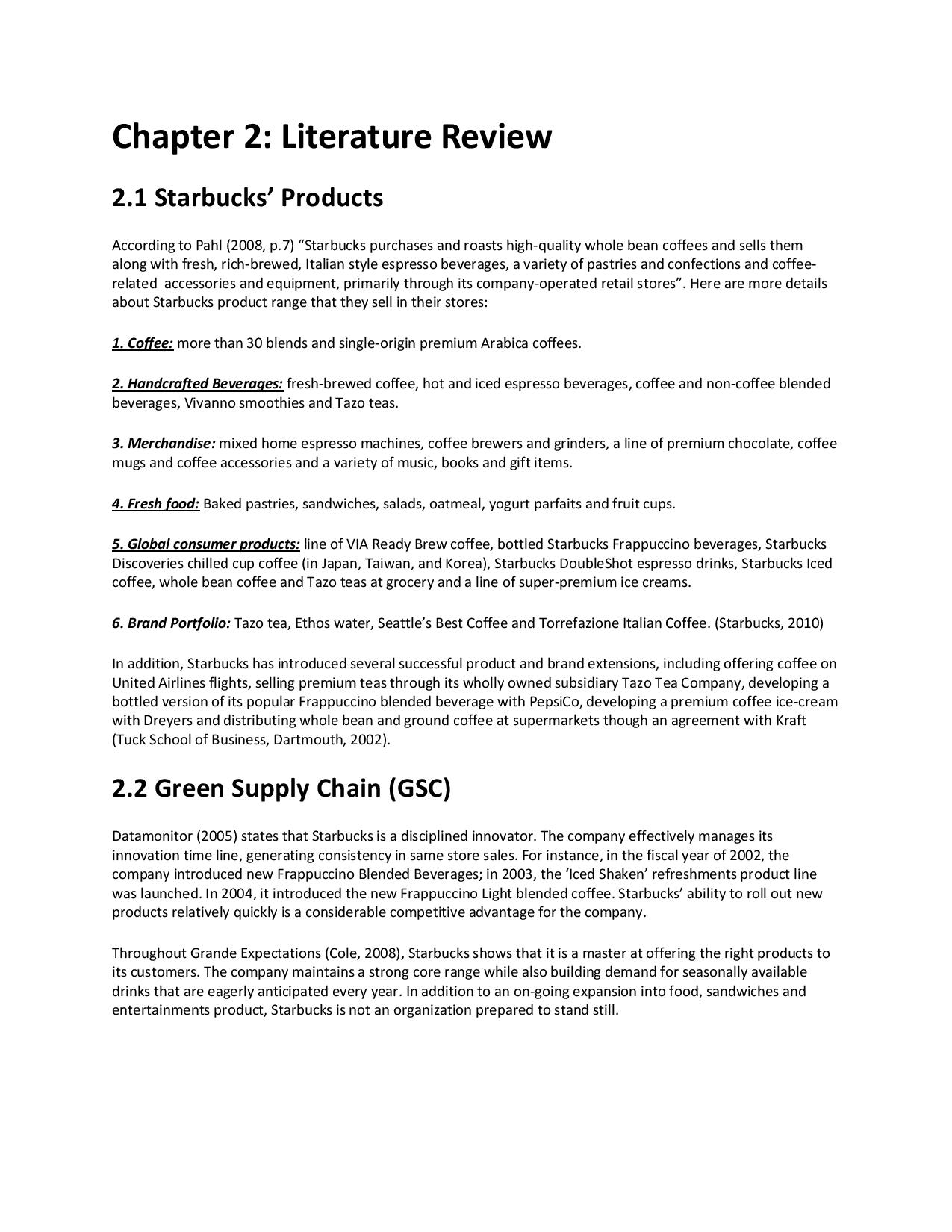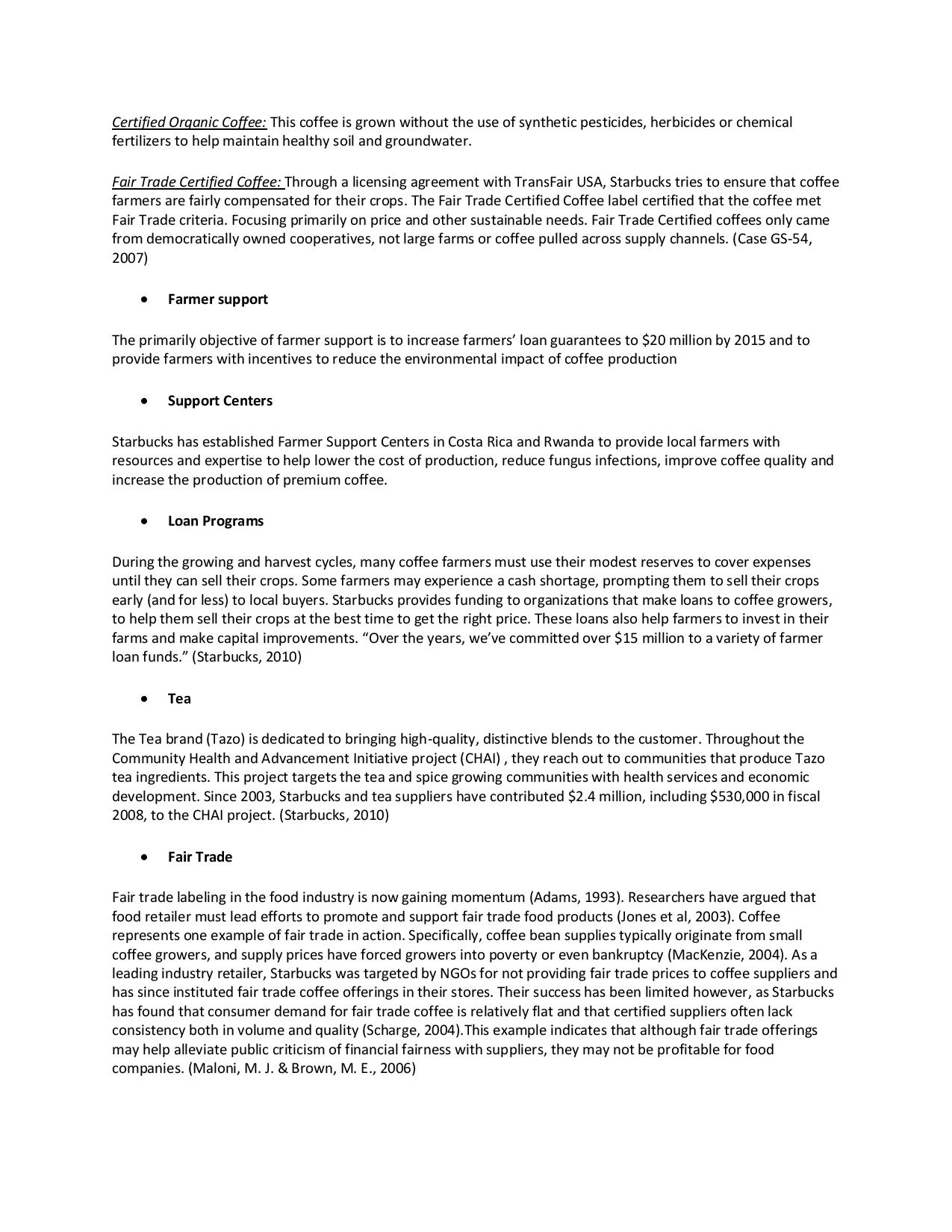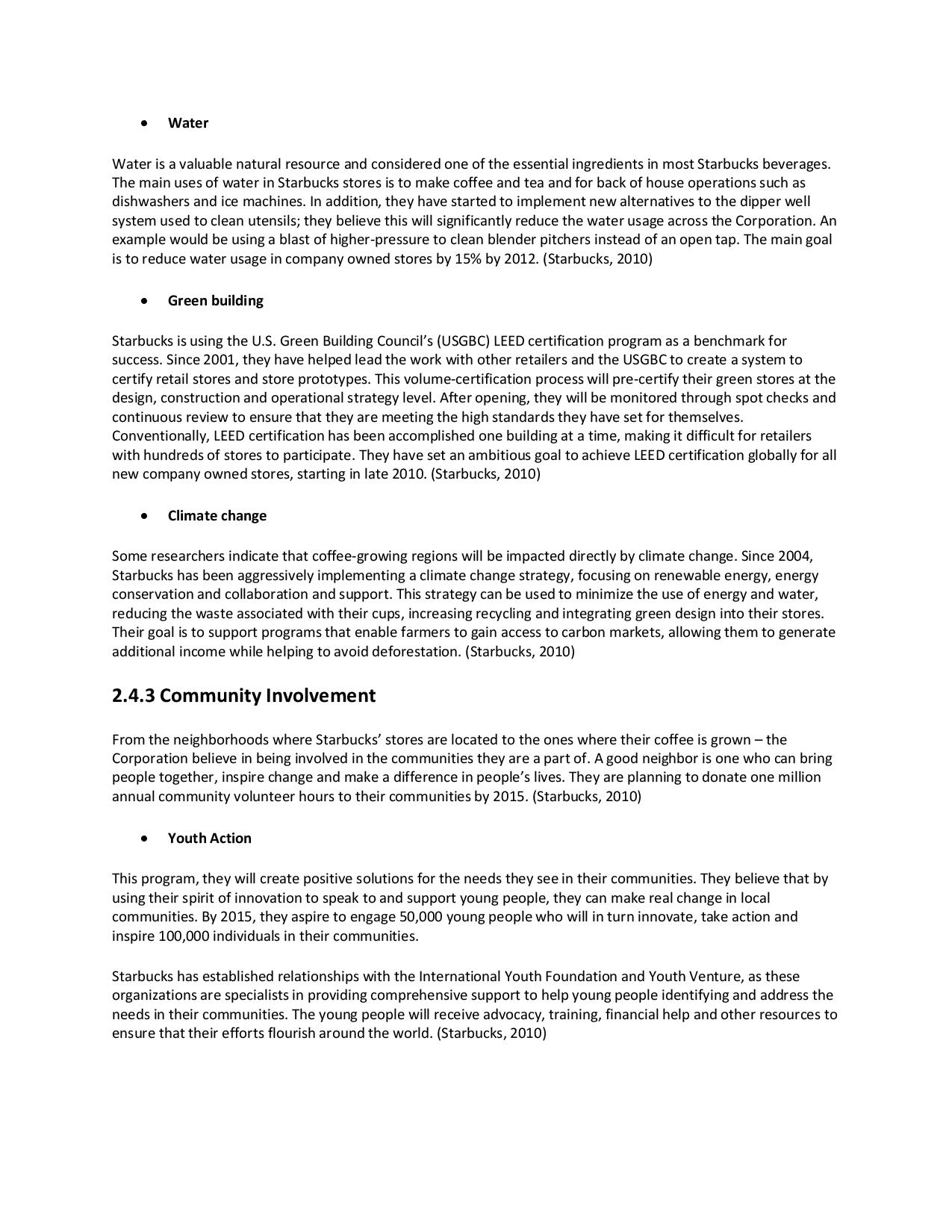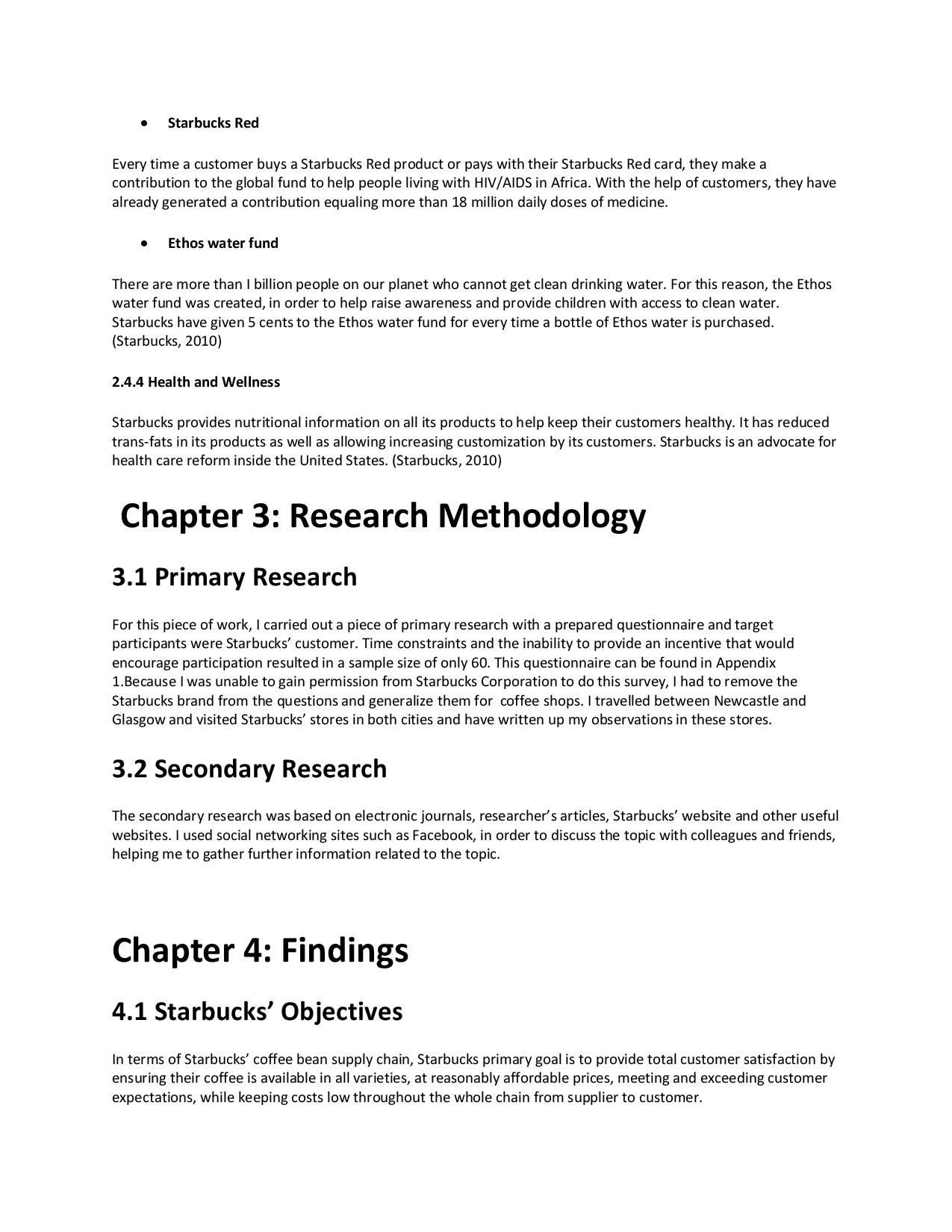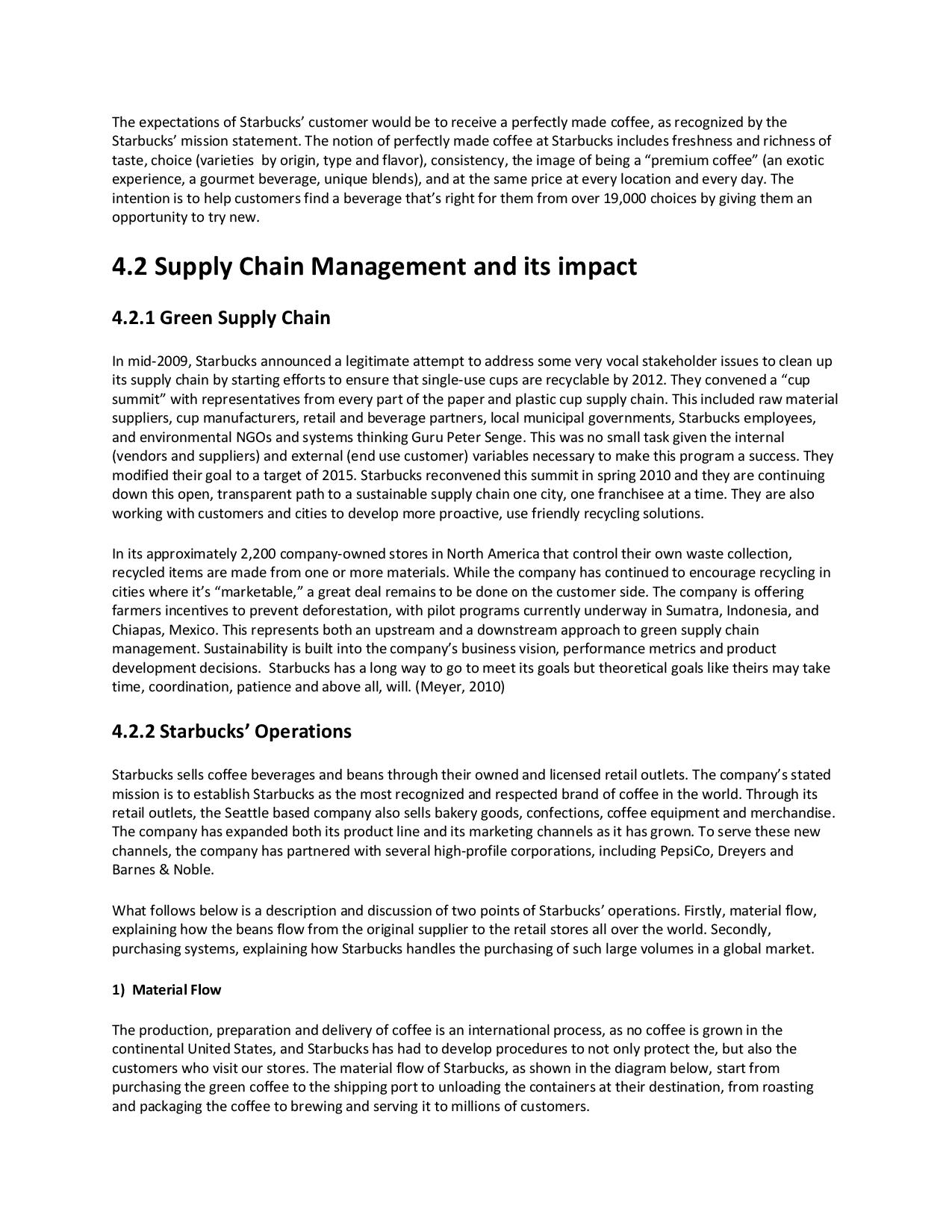Answer the following questions according to the case (Supply Chain Management in STARBUCKS and its Impact on Company Performance) provided below the asked questions:
- What are the main issues that Starbucks faced with its supply base in 2005? How did it approach this problem?
- What are the main benefits from C.A.F.E. for Starbucks?
- What are the main challenges in implementation of C.A.F.E.?
Note: The above questions can be answered from the case provided below:
Supply Chain Management in STARBUCKS and its Impact on Company Performance (Stanford case #GS-54) Chapter 1: Introduction 1.1 History of Coffee Evidence suggests that coffee was first discovered as a hot beverage in Eastern Africa during 11th century, in an area known today as Ethiopia. Today, coffee is a giant global industry employing more than 20 million people. This commodity ranks second only to petroleum in terms of dollars traded worldwide. With over 400 billion cups consumed every year, coffee is the world's most popular beverage. In the United States, sales of premium specialty coffees have reached the multibillion-dollar level, and are increasing significantly on an annual basis. (Coffee Universe, 2011) 1.2 Formation of Starbucks In 1985, Starbucks was formed under the direction and leadership of Howard Schultz. Schultz presently serves as the Chairman of the Board as well as leads visionary of the trade. Starbucks purchases, roasts and sells high-quality whole bean coffees primarily through Trade-operated retail stores. (Starbucks website, 2010) In addition, it sells fresh coffees, Italian-style espresso drinks, chilled and blended beverages, a selection of complimentary food items, coffee related accessories and equipment, along with a selection of premium teas and a line of compact discs, 1.3 Company Overview The original Starbucks was formed in 1971 by three academics- English teacher Jerry Baldwin, history teacher Zev Siegel and writer Gordon Bowker who opened the first store in Seattle that they called "Starbucks Coffee, Tea, and Spice". These partners named the brand Starbucks after the coffee-loving first mate in Melville's Classic Novel "Moby Dick". The name resonated with the romance of the high seas and seafaring coffee traders. The logo of Starbucks Company was based on an old 16th century Norse woodcut: a two tailed mermaid siren encircled by the Store's original name The Company grew slowly and by the early 1980s had a roasting plant and 4 retail stores that sold whole-bean coffee in the Seattle area. Starbucks has been profitable every year since it commenced trading. In March 1987, Jerry Baldwin and Gordon Bowker decided to sell the whole Starbucks operation in Seattle - the stores, the roasting plant and the Starbucks name. Schultz raised capital and immediately bought the company. The new name of the combined companies was Starbucks Corporation. When Howard Schultz was 34 years old, he became Starbucks' president and CEO. In 1989, Schultz brought in Howard Behar who was familiar with opening and running multiple units. The following year, Orin Smith joined Starbucks as their Chief Financial and Operations Officer. Both Smith and Behar were 10 years senior to Schultz and brought with them seasoned experience to help build the Company's infrastructure. ByPurchasing coffee beans form the point of origin 1. Starbucks is required to have the submitted material tested for contamination before it is disposed of, after receiving shipping containers of coffee beans at the roasting plant with the customer seals in place. 2. Starbucks implemented GPS tracking devices on some coffee shipment to monitor their progress from farm regions to shipping ports, ensuring that coffee has not been stolen or tampered with en route. 3. Starbucks implements rigorous quality control procedures, the coffee is inspected at various points, sampled at several points. and tested numerous times to ensure that what arrives in stores is the same coffee that buyers found at the point of origin. 4. Starbucks coffee buyers have to travel the world in search of the best coffees available, even in regions where economic or political instability create hazards for travelers. 5. After the coffee is roasted, it will be placed in the warehouse until required by the production schedule. The coffee is sampled, roasted and cupped to make sure it is the same coffee that was purchased. 10% of the bags will be sampled and compared to the flavor prole that was established from the point of origin. Once it has passed the taste test, the coffee will be loaded into roasting system Roasting Plants Once the container of coffee finishes itsjourney from the point of origin. Starbucks receive it at one of their three U.S. roasting plants or at their European roasting plant in Amsterdam. Todafs coffee roasters use computerized controls to help identify any hot spots and internal quenching systems to cool the coffee beans down if the temperature gets too high. Distribution Centers When the coffee has been packaged, it is sent to the Distribution Centre (DC), where it is picked by partners filling store orders. Stores Once the coffee arrives at one of the stores, it is available for retail sale either as whole bean coffee or as a component in one of the hand-crafted beverages. 2} Purchasing System Although most coffee is purchased in the commodity market, coffee of the quality sought by Starbucks is usually purchased on a negotiated basis at a substantial premium above commodity coffees, dependent on supply and demand at the time of purchase. After a new coffee has been purchased and sold for a period, Starbucks will implement quality control to produce high-quality green beans that can be sold to specialty coffee companies. Starbucks is always concerns about the supply chain management for its coffee beans as a priority and creates many programs to ensure this process is both effective and efficient for all stakeholders: 1. In 2000, Starbucks introduced a line of fair trade products and now offers three options for the socially conscious coffee drinker. Starbucks have become the largest buyer of Certified Fair Trade coffee in North America [10% of the global market) and the only company licensed to sell Certied Fair Trade coffee in 23 countries. 2. Starbucks entered into fixedprice purchase commitments in order to secure an adequate supply of quality green coffee beans and to limit its exposure to fluctuating coffee prices. Starbucks is confident in the subsequent relationships and believes the risks of non-delivery on purchase commitments are remote. 3. During the past year Starbucks has been developing a new set of coffee sourcing guidelines. These sourcing guidelines are a exible point system that rewards performance in sustainable categories with nancial incentives. Ultimately. those who qualify for 100 points will be granted preferred supplier status with the Company's coffee buyers. This program is called Preferred Supplier Program (PSP). Starbuck's Consideration in Purchasing Starbucks' concern about the quality of the coffee bean is due to their aim to establish Starbucks as the most recognized and respected brand of coffee in the world. However, quality is not everything in the eyes of Starbucks. Bea ns-Related Concerns to Better Choose the Supplier There is the Starbucks program to find the effective supplier, \"Preferred Supplier Program {PSP)\". This is a set of guidelines which will not only protect high quality standards but will also promote the long term viability of quality, economic and environmentally sound practice. Starbucks sets the program and requests the supplier to meet the specic requirement. Preferred supplier status will be awarded to vendors who achieved a score of 100 points. {Starbucks Corporation, 2011) The first dimensions in the Preferred Supplier Program (P5P) relate to the beans: 1. Quality Criteria: Prerequisite: every coffee must meet Starbucks quality standard in order to be considered for purchase. High quality is an integral component of sustainability at all levels of the coffee supply chain. 2. Quality varieties: the company will purchase only Arabica varieties of coffee. 3. Flavor characteristics: Starbucks cup quality standards are based on specic descriptions for each coffee purchased. Every coffee is expected to represent the avor character unique to the country or region. All coffees are expected to provide a perfectly clean cup, with medium to heavy body and excellent aroma. All washed coffees must be of good hard bean [or better density) and have good acidity. Other-the n-Beans-Related Concerns to Better Choose the Supplier Other elements in Preferred Supplier Program lPSP) are those not related to the beans: 0 Environmental Impacts 0 Soil management: Farm management practices should effectively control erosion and enhance soil structure and fertility, relying as far as possible on means such as organic fertilizers, covering crops, mulch and compost. 0 Water reduction: Coffee should be processed using methods that reduce water consumption. 0 Clean water: Coffee should be processed using methods that prevent pollution of surface water and ground water. 0 Water buffer zone: Vegetative buffer zones should be in place adjacent to all water sources. No alteration should be made to the courses or hydrology of streams or other surface water bodies. 0 Energy use: Coffee growing, processing and drying should use energy efciently, employ renewable sources wherever possible and not rely on rewood obtained from forest clearing. For example, patio drying should be used as much as practical and solar coffee drying technology employed where feasible. 0 Acceptable agrochemical: Coffee production systems should minimize and wherever possible eliminate inputs of agrochemicals such as chemical pesticides and synthetic fertilizers. 0 Waste management: Waste and coffee lay-product are managed to minimize environmental impacts by applyingthe principles of reduction, reuse and recycling e.g. composting or recycling of coffee pulp and parchment. 0 Economic issues Coffee production systems and commercialization should benet rural communities by boosting producer incomes, expanding employment and education opportunities and enhancing local infrastructure and public services. In order for coffee production to be sustainable, it must be economically viable at all levels of the supply chain, from seed to cup. I Long-term relationships: Starbucks seeks to develop long-term trading relationships with preferred suppliers. . Incentives: Through its purchasing and pricing policies, Starbucks seeks to provide incentives and support for sustainable coffee production, processing and shipping methods. I Economic transparency: In order to ensure that the entire supply chain farmer, miller, exporter and importer benet from the Starbucks preferred supplier program, vendors are expected to provide reliable documentation regarding prices paid to their suppliers. Chapter 5: Discussion] Data analysis 5.1 Starbucks' Strategy Starbucks Corporation's growth utilized mainly a differentiation strategy but also a cost leadership strategy. Its differentiation strategy was exemplied by their stores providing a full experience, offering interesting coffee- related drinks, in a theatrical atmosphere, their unique coffee blending and roasting process creating an extensive product variety, their highly trained employees, exceptional service and their ability to nd the perfect location for their stores. This enabled them to maximize marketshare in a given area of a city and build their regional reputation, which then increased their image to a national level of high prestige and status. For all these reasons, consumers were willing to pay a premium on their product. Their cost leadership strategy was exemplified by their supply chain operations, whereby they received the best transportation rates and were able to achieve economies of scale by eliminating redundancy and maximizing efciency. Starbucks was also a cost leader due to its good relationship with coffee exporters who were "very anxious to become Starbucks suppliers\this objective: RFID for "dark deliveries\" by suppliers and for shipping containers [Operation Safe Commerce), Integrated Supply Chain Operating systems, Lean Operations, Inventory Control and forecasting accuracy, high-tech roasting and grinding equipment, automated POS systems, Distribution Resource Planning [DRP), Transportation Requirement Planning [TRPi and Enterprise Requirement Planning [ERP) systems. I Purchasing One of the factors that has made Starbucks successful was the use and purchase of high quality coffee beans. In order to have competitive advantage over its competitors, Starbucks' purchasing personnel need to visit coffee- producing countries on a regular basis. The visits form better relationship with growers and exporters, allows checks on agricultural situations and crop yields and supports the search for diversity and sources that would meet Starbucks' critical standards for quality and flavor. With a strong belief that being successful in the coffee business is due to the quality of coffee beans, Starbucks has been the leader on contributing and promoting the preservation to the environment and community in coffee- origin countries. The company has a policy on paying prices high enough to small coffee growers, to allow them to cover the production cost and have a better standard of living. I Distribution & Warehousing Distribution and warehousing functions will be the final steps in delivering the product to the end customer, again, minimizing costs and maximizing profits. Long-term agreements with logistics providers and foodservice distributors e.g. Sysco 8L HAVI complement the Companyoperated retail stores and the network of distribution channels. This includes retail and grocery store licensing agreements, wholesale club accounts, joint ventures and direct-to-consumer channels, via mail orders and online. Convenience stores, department stores, movie theatres, businesses, airports, schools and medical facilities are other examples of the distribution network. 5.3 Value Chain Analysis By examining each of the activities of the value chain, we find that Starbucks is very strong in almost all parts of it primary activities - Inbound Logistics! Operations 2' Outbound Logistics [Service Inbound Logistics - Suppliers 8i Logistic Centre Starbucks has a formal process for developing both strategic and operating plans, which ensures it links manufacturing, procurement and logistics to the needs of the business. The material flow of Starbucks, starts from purchasing the green coffee, to the shipping port, to unloading the containers at their destination, from roasting and Packaging the coffee to brewing and serving it to millions of customers. In orderto establish a highly organized and efficient logistic system, the following practices have been implemented: I Modernized Information Systems ensure that the information flow is efficient but Starbucks can revert to manual processes if required. The IT manager in each store controls the allocation of the goods through the database which enhances the efficiency of Starbucks' inventory. Starbucks combines this with manual processes so that staff knows how to make alternative arrangements in an emergency. I Distribution centers ensure the efficient management of inventory to better fulfill the requirements from all stores globally from a convenient location. The company recently announced its intention to establish a 125,000 square foot distribution center in suburban Nashville. The distribution center will provide logistics and shipping services to 900 Starbucks locations from Wisconsin to Florida. Their major distribution center at Memphis, is also the home to Federal Express Corp., the world's major overnight cargo handler, and Ingram Micro, one of the nation's largest distribution companies. This helps Starbucks to achieve efficient transportation from the distribution center to its stores. I Reliable logistic partner and great supplier partner: Starbucks strives to maintain good relationships with their key business partners, their suppliers, distributors and vendors; this process adds value by having an understanding of basic backups and efficient service. Operations Products The main strength of Starbucks' operations is its ability to provide high standard quality products throughout the world. In every Starbucks store, regardless of location, customers need never have concerns about the quality of the product. This standardization guarantees that Starbucks enjoys a reliable reputation for its products and this strongly consolidates the long-term relationship with its customers. Outbound Logistics - Distributors Starbucks is much more exible in its distributions channels than other companies. The distribution channels divide into two parts: company-operated store and non-company channels. Although the non-companyoriented channels account for a very small percentage of sales, this channel involves partnerships with several important distributors, enabling the company to reach more customers through diversified channels. Some of the partners in North America are: 0 Joint Venture: Hyatt Hotel, Pepsi {bottled Frappuccino beverages), Dreyer - Partnership: Albertsons, Safeway, Draft Foods - Direct sales: on-line/ mail order http://www.starbuclcsstore.com/ Starbucks' Competitive Advantages Competitive advantages sustain the company's continuing growth in market share, customer base and business exploration and each successful company has its particular characteristics. Analyzing the competitive advantages of a company is an important step to better understand the secret behind their business success. The three main features on competitive advantages of Starbucks are product, service and distribution and logistics. Competitive Advantages Related to the Products Starbucks provides standard high quality of products throughout the world: High quality control In orderto achieve this high quality, Starbucks takes the process of choosing their coffee beans one big step further, by insisting that their purchasing managers experience the supplier countries although they don't generally buy coffee directly from the farm. They meet the people who cultivate the coffee and develop relationship with them. Through this process, they have achieved the best quality control the for their coffee bean and developed strong and solid supplier relationships. This competitive advantage supports Starbucks by always providing the customer the highest quality of products, reducing the indirect cost which might be generated during the process and also enhancing the relationship between their suppliers and Starbucks. Encouragement of high product innovation levels Starbucks invests considerable funds in developing new products and new features to meet customer needs. Starbucks encourages a creative mind to bring new environments and experience to customers, such as introducing breakfast, music selling and other cookware selling. This innovative spirit provides Starbucks with the competitive advantage to maintain the leading position in coffee industry. (Koehn, 2005). Competitive Advantages Related to Services Starbucks provides 'legendary service' and a fcoffee experience' Starbucks not only provides the best service to their customers, but they aim to provide a 'legendary service'. Each employee is trained to deliver the Starbucks' style, elegance and. The coffee experience each customer gets from a Starbucks store is far more unique and special. The artistic design of each coffee shop, the background music and the whole atmosphere, aims to deliver the most fashionable coffee drink in the country. {Moon 8: Quelch, 2004). Starbucks' innovation creates unique service Starbucks provides a wide service and supplies based on customer needs, such as On-line sales, Prepaid card and Preorder and High Speed Internet in store. Customers can even make their order through their mobiles before entering the store, to avoid queues. Competitive Advantages Related to Distribution and Logistics Starbucks exploits more channels of distribution than its competitors. 1. Company-operated stores: Franchised stores and license stores contribute to Starbucks' rapid global grth. 2. Noncompany-oriented channels: Joint Ventures with Hyatt Hotel, Pepsi and with Dyner and partnerships with Albertsons, Safeway and other supermarkets who have built Starbucks coffee shops have greatly increased its market share. 3. On-line order and sell and mail-order: these new distribution channels provide the greatest convenience to the customer, whilst increasing its sales volume and convenience base. 5.4 Porter's Competitive Forces Model I have used Porter's Competitive Forces Model to analyze the competitiveness of Starbucks. This model recognizes five major forces that could endanger Starbucks position in the coffee industry. namely the threat of new entrants, bargaining power of customers and buyers, bargaining power of suppliers, substitute products or services and the intensity of rivalry among competitors. Threat of new entrants The threat of new entry is considered to be low since the start up costs for this business concept are relatively high. Starbucks is a well established brand for coffee lovers; it is not easy for new entries to imitate this concept in short run. There are several barriers that discourage new entries to this market. Economy Product differentiation Access to distribution channels Intangible barriers to entry Unique services I When the economy is good, threat of new entries may be slightly high and some businesses will start up. If the country is facing economic crisis, new business may not start up as easily. However this can also affect Starbucks' business in long run; a strong economy will lead to good business and vice verse. I The Starbucks store offers a complete menu of Starbucks internationaily beverages, pastries and coffee accessories in addition to Tazo\" teas, espresso, fruit juices etc. They import coffee beans from Colombia, Sumatra, Indonesia, New Guinea, Costa Rica and offer various types of cheese cakes, muffins and cookies with their own secret recipe that is difficult to imitate. They also offer special customer loyalty promotions and festive promotions. Start-up entrepreneurs will fight for recognition as, in general, customers are risk averse and at the same time, they must source beans and supplementary product lines. Even with good managerial skills, training, collaboration, marketing can still hinder success. I Starbucks' distribution channels are wide; there are around SD Starbucks outlet in Malaysia alone, more than 503 in Japan and 5000 outlets worldwide. This strong brand makes it difcult for new entries to compete. Starbucks has spent very little money on advertising, preferring instead to build the brand, cup by cup with customers and to depend on word-ofmouth and the appeal of its storefronts. I Intangible barriers to entry such as the reputation of Starbucks intimidates new entrants to the market. Customers go to Starbucks for its coffee and the comfortable environment And although a cup of coffee costs only 40 cents, customers are happy to pay $4.00 for the atmosphere, music, wi-fi and brand. The company went to great lengths to make sure the store fixtures, merchandise displays, color schemes, artwork, banners, music and aromas all blended to create a consistent, inviting, stimulating environment that evoked the romance of coffee and that rewarded customers. 0 Starbucks integrates with 'Hear Music' which offers a new experience for customers, combining coffee drinking, Internet surfing and listening to music. This is difcult to for newcomers to match. New entries must first consider are they able to compete with Starbucks and can they deliver a unique service? Power of Customers and Buyers The bargaining power of customers when purchasing coffee is high as there are many alternatives to choose from, such as McDonald's Corporation, Green Mountain Coffee small restaurants and coffee shops. All coffee companies use the same product - coffee beans and competition is based on quality of roasting, product innovations, variety and excellence of service. As a result, it is easy for the customers to switch between competitors and competition for brand recognition is very high. As time passes, many people have learned to distinguish and differentiate the taste of good coffees, increasing the buyer bargaining power. Since coffee can be bought almost everywhere the switching costs are very low and product differentiations are minimum. Therefore, buyers have all the power to make a choice. In the future, the bargaining power of buyers in seems uncertain. The quality of coffee that Starbucks provides helps maintain customer loyalty, but the increasing the threats of substitution may lead to a higher bargaining power on the part of the customer. Power of Su Iiers The bargaining power of coffee suppliers is low as coffee is considered a commodity, which usually renders the supplier a lack of power. Starbucks has contracts in place that secure its exclusivity to the coffee suppliers. which means there is a reliable continuous flow of supplies without the threat of potential competition for resources. Starbucks is developing a stronger relationship with its suppliers. It proactively ensures that there is fair treatment of foreign subcontractors, child labor procedures, minimum working conditions and wages and this relationship can prevent future breakdowns in supply. Threat of Substitute Products The threat of substitute products to Starbucks coffee is moderate. An example of a substitute product would be the premium coffee products available in the supermarkets. Customers usually turn to substitute products because of convenience and cost. However, from the coffee quality point of view, Starbuck's coffee is better. Competitive threats can also originate from noncoffee related products, such as tea, juices and soft drinks. People who are coffee-lovers will always stick to coffee, but people who drink coffee to combat fatigue will drink non- coffee related products interchangeably. Since there are no natural substitutes for coffee beans, the actual specic threat is considered to be low. The Intensity of Rivalg among Existing Competitors The rivalry among existing competitors is relatively high, due to the lack of genuine product differentiation which leads to ercer competition. Among the strongest competitors of Starbucks are Gloria Jean's and Florida-based coffee chain Brother's Gourmet Many of the local and regional chains merge in efforts to grow and better position themselves as an alternative to Starbucks. In addition, restaurants are picking up on the growing popularity of specialty coffees and have installed machines to serve espresso, cappuccino, latte, and other coffee drinks to their customers. Starbucks also faces competition from nationwide coffee manufacturers such as Kraft General Foods [the parent of Maxwell House) and Nestle. which distributed their coffees through supermarkets and specialty coffee companies that sell whole-bean coffees in supermarkets. Because many consumers habitually purchase their coffee supplies at supermarkets, it is easy for them to substitute these products for those of Starbucks. 5.5 Survey analysis How often to do you drink coffee? Why do you drink coffee? Do you consider drinking coffee to be a part of life style choice? Do you consider drinking coffee in a caf a part to be a luxury? Why do you visit coffee shops? Have you heard about Corporate Social Responsibility (CSR}? Are you familiar with Coffee 31 Farmer Equity (CA.F.E.}? Are you aware that coffee shops use responsibly grown coffee beans? Would you be willing to pay more for a cup of coffee if it was fairly traded and responsibly grown? Which age category are you in? Chapter 6: Conclusion Starbucks' strategy is fairly simple: reach customers where they work, dine, travel and shop. This was achieved by increasing the perception of a high quality commodity product, adapting stores to the customers' lifestyle and blanket developing areas completely, even if the stores cannibalize one another business. The company's approach cuts down on delivery and management costs, shortens customer lines at stores and increases foot traffic for all the other stores in an area. Integration of the activities will help Starbucks to achieve their objectives. This integration plays a crucial role in the whole Starbucks' supply chain, as poor performance or failure at any step or activity of the supply chain will jeopardize the whole venture. Examples of activities and elements involved in this integration include building long-term relationships with suppliers, elimination of obstacies to cooperation, establishing common goals and tools for cooperation, strategies and tactics, analysis and sharing of information by all supply chain participants. An example of such activities at the beginning of the chain would be the work with coffee growers on cultivation practices that improve coffee quality and provide consistency and continuity. This in turn better matches the roasting process, allowing for paying premium prices to growers which then contribute to creating a sustainable source of coffee beans through C.A.F.E. practices. etc. Socially responsible organizations consider themselves to be part of a larger society and that they are accountable to that society for their actions. As with ethics, agreement on the nature and scope of social responsibility is often difficult, given the diversity of values present in different societal, business and corporate cultures. In order to have a sustainable business, Starbucks need a reliable and responsible supplier base that can keep pace with its growth. Starbucks invests in measures to ensure its suppliers have the opportunity to do this. An example of this is C.A.F.E. Practices, which give preference to verified suppliers by paying premium prices and signing potentially longterm contracts. Companies have responded to these ethical and environmental concerns by what is termed 'green marketing' i.e. marketing efforts to produce, promote and reclaim environmentally sensitive products. Starbucks has committed to purchase wind power to offset a portion of the energy used in its operations, set targets for reducing its emissions and defined a renewable energy initiative to reach its environmental targets. References Adams, R. {1993), 'Green Consumerism and the Food Industry: Further Developments', British Food Journal. 95 {4), pp. 9-11. Case GS-54 (2007). Starbucks Corporation: Building a sustainable supply chain. Stanford graduate school of business. Coffee Universe (2011). Coffee's Journey around the World. Available at: http://coffeeuniverse. com/world coffee.html (Accessed: 14 January 2011). Cole, G. (2008) 'Management Decision' Review of Grande Expectations: a Year in the Life of Starbucks' Stock, by Karen Blumenthal. Journal of Management History, 46 (4), pp. 673-675. Datamonitor (2005). 'Company Spotlight: Starbucks'. Jones, P., D. Comfort and D. Hillier (2003) 'Retailing Fair Trade Food Products in the UK', British Food Journal, 105 (10/11), pp. 800-810 Mackenzie, C. (2004), 'Bitter Harvest', Canadian Business. 77 (10), pp.43 Maloni, M. J. & Brown, M. E. (2006), 'Corporate Social Responsibility in the Supply Chain: An Application in the Food Industry', Journal of Business Ethics. 68, pp.35-52 Mayer, D. (2010). A Green Supply Chain Takes a Systems Thinking Approach-And Patience. Available at: http://theenergycollective.com (Accessed: 25 February 2011) Moon, y. & Quelch, J. (2004) Starbucks: Delivering Customer Service. Harvard Business School Pahl, N. (2008) The Idea Behind the Starbucks Experience: The Main Elements of Starbucks' Strategic Diamond. Google Books [Online]. Available at: http://books.google.com/books?id=monRIzBF4q0C&printsec=frontcover&dq-the+idea+ behind +the+ starbucks +exp erience: +the+main +elements+ of+starbucks' + strategy +dimond&hen#v-onepage&q&f-false (Accessed: 21 December 2010) Scharge, E. (2004), 'Supply and the Brand'. Harvard business Review 82 (6), pp. 20-21. Schultz, H. & Yang, D.J. (1997), Pour Your Heart Into It "How Starbucks Built A Company One Cup At A Time". New York. Starbucks Coffee Company (2010) Menu. Available at: http://www.starbucks. com (Accessed: 20 December2010) Starbucks Coffee Company (2010). Community Involvement. Available at: http://www.starbucks. com (Accessed : 20 December 2010) Starbucks Coffee Company (2010). Environmental Stewardship. Available at: http://www.starbucks.com (Accessed: 24 December 2010) Starbucks Coffee Company (2010). Being a Responsible Company. Available at: http://www.starbucks.com (Accessed: 20 December 2010) Starbucks Coffee Company (2010). Ethical Sourcing. Available at: http://www.starbucks.com (Accessed: 20 December 2010)1991, Starbucks had ventured into the mail-order catalogue business, licensed airport stores, expanded into California and had just over 100 stores. The company went public in 1992. [Case (SS-54, 2007) By 2005, Starbucks had more than 10,200 company operated and licensed stores in more than 35 countries. The stores offered coffee drinks, and food items, as well as beans, coffee accessories, teas, and music. Starbucks Corporation operated more than 5,200 stores in 10 countries {80% in the U.S. which were located primarily in shopping centers and airports), while licensed operators more than 2,800 units in 28 countries. . The company also owned and licensed the Seattle's Best Coffee and Torrefazione Italia chain in the United States with more than 100 shops. In addition Starbucks marketed its coffee through grocery stores and licensed its brand for other food and beverage product. Most recent figures from January 2, 2011 show the total store count for Starbucks Corporation as 17,009; 8,870 owned stores and 8,139 licensed stores. {Starbucks Company Prole, 2011) 1.4 The specialty coffee industry and the Starbucks coffee Supply Chain The specialty coffee industry has grown dramatically, especially in the period between 19805 and 19905. A large number of specialists felt that the differentiated coffee supported by the specialty industry would continue to expand much faster than conventional coffees. Nevertheless, the definition of specialty in the United States continued to be refined. By 2005, it included less quality and flavored coffees and the industry began to redefine "specialty\" as meaning quality. Coffee beans come from all over the world; from East Africa, Pacific Rim, and Latin America. The farms range in size from 5 acres for traditional farms to large plantations covering thousands of acres. Between 50 to 70% of the global coffee supply comes from small-scale farms. These small producers generally don't own the mills that used to process the product from cherry to bean. While some did operate as part of a cooperative, not all small -scale farmers had this as an option. Often, mills were owned and operated by the large farms and consequently small farmers had little leverage when negotiating prices with the larger owners. Coffee must be processed and it was common for small farmers to accept a considerably lower price to be able to get their coffee to market. Starbucks also purchase coffee through agents from individual estates, producer associations, suppliers or directly from the processors. 1.5 The Company Mission Statement According to Schultz, H. S: Yang, DJ. [1997), the mission statement of this company is to \"Establish Starbucks as the premier purveyor of the nest coffee in the world while maintaining our uncompromising principles as we grow\". These uncompromising principles have led the company to specific and imperative policy decisions. In order for Starbucks to measure the appropriateness of their decisions, they use the foliowing six guiding principles: Provide a great work environment as well as treat each other with of respect and dignity. Embrace diversity as an important component in the way we do business. Apply the highest standards of excellence to the purchasing, roasting and fresh delivery of our coffee. Develop enthusiastically satisfied customers all of the time. Contribute positively to our communities and our environment. Recognize that profitability is essential to our future success. F'P'PP'PP Starbucks Coffee Company (2010). Wellness. Available at: http://www. starbucks. com (Accessed: 20 December 2010 Starbucks Coffee Company (United Kingdom) (2009). A Brief History of Starbucks. Available at: http://starbucks. co.uk (Accessed: 18 December 2010) Starbucks Coffee Company (United Kingdom) (2009). Our Starbucks Mission. Available at: http://starbucks.co.uk (Accessed : 18 December 2010) Starbucks Company Profile (2011) Available at: http://assets.starbucks. com/assets/company-profile-feb10.pdf Accessed: 24 December 2010) Starbucks Corporation (2011), our world of Coffee. Available at: http://www.starbucks. com Tarantino, David (2007). Starbucks Corporation (SBUX): Comments on Q1. Robert Baird & Co. Tuck School of Business at Dartmouth (2002). 'Starbucks Coffee Company'.Chapter 2: Literature Review 2.1 Starbucks' Products According to Pahl (2008, p.7) "Starbucks purchases and roasts high-quality whole bean coffees and sells them along with fresh, rich-brewed, Italian style espresso beverages, a variety of pastries and confections and coffee- related accessories and equipment, primarily through its company-operated retail stores". Here are more details about Starbucks product range that they sell in their stores: 1. Coffee: more than 30 blends and single-origin premium Arabica coffees. 2. Handcrafted Beverages: fresh-brewed coffee, hot and iced espresso beverages, coffee and non-coffee blended beverages, Vivanno smoothies and Tazo teas. 3. Merchandise: mixed home espresso machines, coffee brewers and grinders, a line of premium chocolate, coffee mugs and coffee accessories and a variety of music, books and gift items. 4. Fresh food: Baked pastries, sandwiches, salads, oatmeal, yogurt parfaits and fruit cups. 5. Global consumer products: line of VIA Ready Brew coffee, bottled Starbucks Frappuccino beverages, Starbucks Discoveries chilled cup coffee (in Japan, Taiwan, and Korea), Starbucks DoubleShot espresso drinks, Starbucks Iced coffee, whole bean coffee and Tazo teas at grocery and a line of super-premium ice creams. 6. Brand Portfolio: Tazo tea, Ethos water, Seattle's Best Coffee and Torrefazione Italian Coffee. (Starbucks, 2010) In addition, Starbucks has introduced several successful product and brand extensions, including offering coffee on United Airlines flights, selling premium teas through its wholly owned subsidiary Tazo Tea Company, developing a bottled version of its popular Frappuccino blended beverage with PepsiCo, developing a premium coffee ice-cream with Dreyers and distributing whole bean and ground coffee at supermarkets though an agreement with Kraft (Tuck School of Business, Dartmouth, 2002). 2.2 Green Supply Chain (GSC) Datamonitor (2005) states that Starbucks is a disciplined innovator. The company effectively manages its innovation time line, generating consistency in same store sales. For instance, in the fiscal year of 2002, the company introduced new Frappuccino Blended Beverages; in 2003, the 'Iced Shaken' refreshments product line was launched. In 2004, it introduced the new Frappuccino Light blended coffee. Starbucks' ability to roll out new products relatively quickly is a considerable competitive advantage for the company. Throughout Grande Expectations (Cole, 2008), Starbucks shows that it is a master at offering the right products to its customers. The company maintains a strong core range while also building demand for seasonally available drinks that are eagerly anticipated every year. In addition to an on-going expansion into food, sandwiches and entertainments product, Starbucks is not an organization prepared to stand still.2.3 Supply Chain Visibility Coffee and Farmer Equity {C.A.F.E.) Practices increased the visibility of Starbucks' supply chain by demanding a documented and veried product as well as documented nancial flows through the supply chains of its suppliers. In the past, Starbucks had very poor visibility in their supply base, as coffee farmers and processors were not very technologically sophisticated or mature in their business processes. By increasing the transparency of their supply base, Starbucks would be able to gain a better understanding of the needs and the working conditions of their suppliers. The increased visibility would allow Starbucks to improve its relationships with growers, who had previously been isolated from them by the coffee exporters and distributors. On a practical note, increased visibility in the supply chain might allow Starbucks to better predict supply shortages as they arose. Since the majority of Starbucks coffee was grown in developing countries in Latin America, Africa, South America, and Southeast Asia, Starbucks had a significant risk of supply shortage due to regional instability. Devoid ofvisibiiity in the supply base, Starbucks could not reliably predict the impact of regional instability on its coffee supply. By raising corporate visibility, regional instability might be linked to a particular quantity of coffee, giving Starbucks advance notice of the need to find alternate sources of supply. This might allow Starbucks to be proactive in managing supply disruptions before they even arose. {Tarantino, 2007) 2.4 Corporate Social Responsibilities (CSR) Starbucks rm are committed to do business responsibly and by conducting themselves in waysthat earn the trust and respect oftheir customers, partners and neighbors. They call Starbucks a shared planet and there are three main areas of focus: ethical sourcing, environmental stewardship and community involvement. (Starbucks, 2010) 2.4.1 Ethical Sourcing Starbucks have developed strong, long-term relationships with farmers all over the world, to make sure that they can buy the high-quality coffee that their customers. By 2015 it hopes that all of their coffee will be grown using ethical trading and responsible growing practices. 0 Coffee C.A.F.E Practices (Coffee and Farmer Equity Practices] Coffee and Farmer Equity {C.A.F.E.) is a Starbucks initiative that has created a set of industry-leading, comprehensive coffee-buying guidelines. These guidelines address the quality of coffee, nancial transparency, and social and environmental responsibility. Starbucks did not use its purchasing power as a way to manipulate its coffee suppliers in order to improve prot margins. Instead they decided to use their market power as a way to implement social change within its supply chain. The C.A.F.E Practices Program helped the company to ensure the sustainable supply of high quality coffee beans, which is an essential component of Starbucks. There are three types of environmental sustainable coffee purchased by Starbucks: Conservation Coee: Through its partnership with Cl Starbucks encouraged coffee farmers to use traditional and sustainable cultivation methods. The basic aim was to protect shade trees, which were often stripped away and replaced with tight rows of coffee trees on large coffee plantations. This not only destroyed biodiversity, but also resulted in lower coffee production. Certified Organic Cofee: This coffee is grown without the use of synthetic pesticides, herbicides or chemical fertilizers to help maintain healthy soil and groundwater. Fair Trade Certified Cofee: Through a licensing agreement with TransFair USA, Starbucks tries to ensure that coffee farmers are fairly compensated for their crops. The Fair Trade Certied Coffee label certied that the coffee met Fair Trade criteria. Focusing primarily on price and other sustainable needs. Fair Trade Certied coffees only came from democratically owned cooperatives. not large farms or coffee pulled across supply channels. (Case 65-54, 2007) I Farmer support The primarily objective of farmer support is to increase farmers' loan guarantees to $20 million by 2015 and to provide farmers with incentives to reduce the environmental impact of coffee production I Support Centers Starbucks has established Farmer Support Centers in Costa Rica and Rwanda to provide local farmers with resources and expertise to help lower the cost of production, reduce fungus infections, improve coffee quality and increase the production of premium coffee. I lean Programs During the growing and harvest cycles, many coffee farmers must use their modest reserves to cover expenses until they can sell their crops. Some farmers may experience a cash shortage, prompting them to sell their crops early (and for less) to local buyers. Starbucks provides funding to organizations that make loans to coffee growers, to help them sell their crops at the best time to get the right price. These loans also help farmers to invest in their farms and make capital improvements. "Over the years, we've committed over $15 million to a variety of farmer loan funds.\" (Starbucks, 2010) I Tea The Tea brand (Tazo) is dedicated to bringing high-quality, distinctive blends to the customer. Throughout the Community Health and Advancement Initiative project (CHAI) , they reach out to communities that produce Tazo tea ingredients. This project targets the tea and spice growing communities with health services and economic development. Since 2003, Starbucks and tea suppliers have contributed $2.4 million, including $530,000 in fiscal 2008, to the CHAI project. (Starbucks, 2010) I Fair Trade Fair trade labeling in the food industry is now gaining momentum (Adams, 1993). Researchers have argued that food retailer must lead efforts to promote and support fair trade food products (Jones et al, 2003). Coffee represents one example of fair trade in action. Specically, coffee bean supplies typically originate from small coffee growers, and supply prices have forced growers into poverty or even bankruptcy (Mackenzie, 2004). As a leading industry retailer, Starbucks was targeted by N605 for not providing fair trade prices to coffee suppliers and has since instituted fair trade coffee offerings in their stores. Their success has been limited however, as Starbucks has found that consumer demand for fair trade coffee is relatively at and that certied suppliers often lack consistency both in volume and quality (Scharge, 2004).This example indicates that although fair trade offerings may help alleviate public criticism of financial fairness with suppliers, they may not be protable for food companies. (Maloni, M. J. 8: Brown, M. E., 2006) 2.4.2 Environmental Stewardship Starbucks share their customer's commitment to the environment and they believe in the importance of caring for the planet and encouraging others to do the same. Their goal is to have 100% of their cups reusable or recyclable by 2015. Moreover, they will work to significantly reduce their environmental footprint through energy and water conservation. recycling and green construction. I Recycling Starbucks is committed to reducing the waste which their stores generate - especially when it comes to recycling. Starbucks' goal is to have recycling available in all of their stores where they can control waste collection and serve 25% of beverages in reusable cups. I Recycling in Stores In the last year, 70% of Starbucks stores recycled at least one type of waste but recycling is reliant on the local availability of commercial recycling. However, there are also some local communities that provide a minimal cost or non-commercial recycling. I Greener Cups Over the years, Starbucks has launched numerous initiatives to decrease the environmental impact of the oneuse cups. I In 1997, they developed their recycled-content cup sleeve that protects customers from hot beverages and avoid the waste of "double cupping.\" I In 2006, they launched the industry's first hot beverage paper cup with 10% post-consumer recycled fibre. I In 2008, they rolled out a new plastic cup that has a reduced environmental impact over the original plastic cups. In 2009. they hosted 3 Cup Summit in Seattle, bringing together all areas of their paper and plastic cup value chain to reach agreement on criteria for a comprehensive recyclable cup solution. (Starbucks, 2010) - Composting In 1995, Starbucks introduced 'Grounds for Your Garden' which offers customers complimentary five pounds bags of used coffee grounds to enrich garden soil. In addition, many stores are able to divert other food waste and coffee grounds from the landfill when commercial composting is available. I Energy The energy used in Starbucks stores makes up nearly 80% of their entire carbon footprint. In the last few years, they have made major progress in understanding and developing new strategies to reduce their energy consumption. They continue to purchase renewable energy and that now represents 20% of the total electricity used in the company operated stores in the US. and Canada. In addition, they are investing in new lighting and improving the efficiency of HVAC (heating, ventilation and cooling) systems and other equipment. They aim to reduce their energy use in new stores by 25% and to obtain 50% of their energy from renewable sources in all of their company owned stores by end of 2010. (Starbucks, 2010) I Water Water is a valuable natural resource and considered one of the essential ingredients in most Starbucks beverages. The main uses of water in Starbucks stores is to make coffee and tea and for back of house operations such as dishwashers and ice machines. In addition, they have started to implement new alternatives to the dipper well system us ed to clean utensils; they believe this will significantly reduce the water usage across the Corporation. An example would be using a blast of higher-pressure to clean blender pitchers instead of an open tap. The main goal is to reduce water usage in company owned stores by 15% by 2012. (Starbucks, 2010) I Green building Starbucks is using the US. Green Building Council's (USGBC) LEED certication program as a benchmark for success. Since 2001, they have helped lead the work with other retailers and the USGBC to create a system to certify retail stores and store prototypes. This volume-certification process will precertify their green stores at the design, construction and operational strategy level. After opening, they will be monitored through spot checks and continuous review to ensure that they are meeting the high standards they have set for themselves. Conventionally, LEED certification has been accomplished one building at a time, making it difficult for retailers with hundreds of stores to participate. They have set an ambitious goal to achieve LEED certification globally for all new company owned stores, starting in late 2010. (Starbucks, 2010) I Climate change Some researchers indicate that coffee-growing regions will be impacted directly by climate change. Since 2004, Starbucks has been aggressively implementing a climate change strategy, focusing on renewable energy, energy conservation and collaboration and support. This strategy can be used to minimize the use of energy and water, reducing the waste associated with their cups, increasing recycling and integrating green design into their stores. Their goal is to support programs that enable farmers to gain access to carbon markets, allowing them to generate additional income while helping to avoid deforestation. (Starbucks, 2010) 2.4.3 Community Involvement From the neighborhoods where Starbucks' stores are located to the ones where their coffee is grown the Corporation believe in being involved in the communities they are a part of. Agood neighbor is one who can bring people together, inspire change and make a difference in people's lives. They are planning to donate one million annual community volunteer hours to their communities by 2015. (Starbucks, 2010) 0 Youth Action This program, they will create positive solutions for the needs they see in their communities. They believe that by using their spirit of innovation to speak to and support young people, they can make real change in local communities. By 2015, they aspire to engage 50,000 young people who will in turn innovate, take action and inspire 100,000 individuals in their communities. Starbucks has established relationships with the International Youth Foundation and Youth Venture, as these organizations are specialists in providing comprehensive support to help young people identifying and address the needs in their communities. The young people will receive advocacy, training, financial help and other resources to ensure that their efforts ourish around the world. (Starbucks, 2010) I Starbucks Red Every time a customer buys a Starbucks Red product or pays with their Starbucks Red card, they make a contribution to the global fund to help people living with HIV/AIDS in Africa. With the help of customers, they have already generated a contribution equaling more than 18 million daily doses of medicine. I Ethos water fund There are more than I billion people on our planet who cannot get clean drinking water. For this reason, the Ethos water fund was created, in order to help raise awareness and provide children with access to clean water. Starbucks have given 5 cents to the Ethos water fund for every time a bottle of Ethos water is purchased. (Starbucks, 2010) 2.4.4 Health and Wellness Starbucks provides nutritional information on all its products to help keep their customers healthy. It has reduced trans-fats in its products as well as allowing increasing customization by its customers. Starbucks is an advocate for health care reform inside the United States. (Starbucks. 2010) Chapter 3: Research Methodology 3.1 Primary Research For this piece of work, I carried out a piece of primary research with a prepared questionnaire and target participants were Starbucks' customer. Time constraints and the inability to provide an incentive that would encourage participation resulted in a sample size of only 60. This questionnaire can be found in Appendix 1.Because I was unable to gain permission from Starbucks Corporation to do this survey, I had to remove the Starbucks brand from the questions and generalize them for coffee shops. I travelled between Newcastle and Glasgow and visited Starbucks' stores in both cities and have written up my observations in these stores. 3.2 Secondary Research The secondary research was based on electronicjournals, researcher's articles, Starbucks' website and other useful websites. I used social networking sites such as Facebook, in order to discuss the topic with colleagues and friends, helping me to gather further information related to the topic. Chapter 4: Findings 4.1 Starbucks' Objectives In terms of Starbucks' coffee bean supply chain, Starbucks primary goal is to provide total customer satisfaction by ensuring their coffee is available in all varieties, at reasonably affordable prices, meeting and exceeding customer expectations, while keeping costs low throughout the whole chain from supplier to customer. The expectations of Starbucks' customer would be to receive a perfectly made coffee, as recognized by the Starbucks' mission statement. The notion of perfectly made coffee at Starbucks includes freshness and richness of taste, choice [varieties by origin, type and flavor), consistency, the image of being a "premium coffee\" {an exotic experience, a gourmet beverage, unique blends), and at the same price at every location and every day. The intention is to help customers find a beverage that's right for them from over 19,000 choices by giving them an opportunity to try new. 4.2 Supply Chain Management and its impact 4.2.1 Green Supply Chain In mid-2009, Starbucks announced a legitimate attempt to address some very vocal stakeholder issues to clean up its supply chain by starting efforts to ensure that single-use cups are recyclable by 2012. They convened a \"cup summit" with representatives from every part of the paper and plastic cup supply chain. This included raw material suppliers, cup manufacturers, retail and beverage partners, local municipal governments, Starbucks employees, and environmental NGOs and systems thinking Guru Peter Senge. This was no small task given the internal [vendors and suppliers) and external (end use customer) variables necessary to make this program a success. They modified their goal to a target of 2015. Starbucks reconvened this summit in spring 2010 and they are continuing down this open, transparent path to a sustainable supply chain one city, one franchisee at a time. They are also working with customers and cities to develop more proactive, use friendly recycling solutions. In its approximately 2,200 company-owned stores in North America that control their own waste collection, recycled items are made from one or more materials. While the company has continued to encourage recycling in cities where it's \"marketable,\" a great deal remains to be done on the customer side. The company is offering farmers incentives to prevent deforestation, with pilot programs currently underway in Sumatra, Indonesia, and Chiapas, Mexico. This represents both an upstream and a downstream approach to green supply chain management. Sustainability is built into the company's business vision, performance metrics and product development decisions. Starbucks has a long way to go to meet its goals but theoretical goals like theirs may take time, coordination, patience and above all, will. [Meyer, 2010) 4.2.2 Starbucks' Operations Starbucks sells coffee beverages and beans through their owned and licensed retail outlets. The company' 5 stated mission is to establish Starbucks as the most recognized and respected brand of coffee in the world. Through its retail outlets, the Seattle based company also sells bakery goods, confections, coffee equipment and merchandise. The company has expanded both its product line and its marketing channels as it has grown. To serve these new channels, the company has partnered with several highprofile corporations, including PepsiCo, Dreyers and Barnes 8: Noble. what follows below is a description and discussion of two points of Starbucks' operations. Firstly, material flow, explaining how the beans flow from the original supplier to the retail stores all over the world. Secondly, purchasing systems, explaining how Starbucks handles the purchasing of such large volumes in a global market. 1) Material Flow The production, preparation and delivery of coffee is an international process, as no coffee is grown in the continental United States, and Starbucks has had to develop procedures to not only protect the, but also the customers who visit our stores. The material flow of Starbucks, as shown in the diagram below, start from purchasing the green coffee to the shipping port to unloading the containers at their destination, from roasting and packaging the coffee to brewing and serving it to millions of customers
